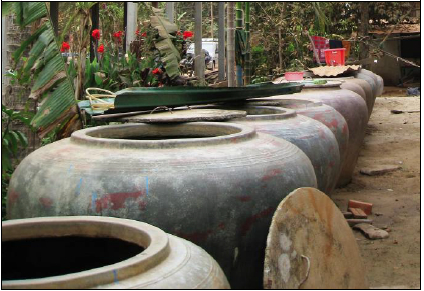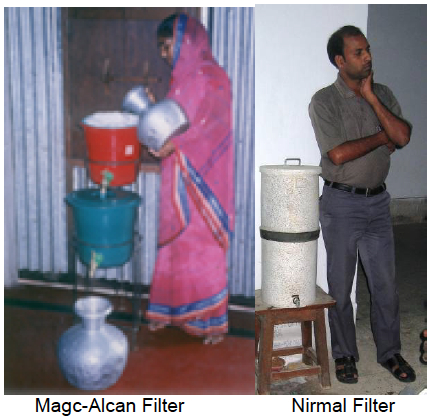Arsenic filter
There are at least five ways to remove arsenic from drinking water. The adsorption method, the coagulation-flocculation method, the surface complexation method, a Kanchan arsenic filter, or removal by oxidation.
Adsorption: Magc-Alcan Filter or the Shapla filter
The Magc-Alcan is a two bucket filter. The buckets are in series and both filled with an American-made activated alumina media. The media has been developed by MAGC Technologies and Alcanof US; and it is produced by thermal dehydration (at 250-1150°C) of an aluminium hydroxide. The Magc-Alcan filter removes arsenic by adsorption (adhesion or sticking together) of the arsenic to the enhanced activated alumina which is porous and has a high surface area. Removal rates can be sensitive to varying pH levels, so additional equipment may be required to control pH levels.
A similar filter called “Nirmal Filter” also exists in India. It uses arsenic adsorption on an Indian-made activated alumina and it is followed by filtration through a ceramic candle. It is less expensive than a Magc-Alcan filter ($10-15 capital cost) but it needs to be regenerated every 6 months. Efficiency: 80-90% arsenic removal.
The Shapla filter is an earthen household arsenic removal technology developed by International Development Enterprises (IDE), Bangladesh. It is based on adsorption (adhesion or sticking together) of the arsenic to the iron on the coated brick chips, which works as well as iron coated sand. The bricks are coated by treatment with a ferrous sulphate solution (Ahmed, 2005). The filter can hold up to 30 litres of water. As water passes through the filter, arsenic from the water is rapidly adsorbed by the iron on the brick chips. The media (20 kg) filters 4,000 litres of arsenic-contaminated water reducing arsenic concentrations to undetectable levels and supplying an average family with 25-32 litres of safe drinking water per day.
Coagulation-Flocculation: Bucket Treatment Unit (BTU)
The Bucket Treatment Unit has been developed within the DPHE-Danida project. It consists of oxidation (loss of electrons of As(III) to form As(V)) and coagulation (clumping of particles to promote sedimentation) processes using potassium permanganate and aluminum sulphate respectively. The water is then filtered through cloth into a second bucket that contains a sand filter. The BTU can be constructed from locally available materials.
Surface complexation: Sono Filter
The Sono Filter is a three bucket system with a composite iron matrix (CIM) as the active arsenic removal component. It creates surface complexation of arsenic on the CIM followed by a filtration. The filter is manufactured from indigenous materials and it works without chemical treatment, without regeneration, and without producing toxic waste. It is efficient to remove arsenic and 22 other heavy metals as well as bacteria.
Kanchan Arsenic Filter
The Kanchan Arsenic Filter (KAF) is an adaptation of the biosand filter. The KAF has been designed to remove arsenic from drinking water, in addition to providing microbiological water treatment. Arsenic removal is achieved by incorporating a layer of rusty nails in the diffuser basin of the filter.
Passive Oxidation
Passive oxidation is based on oxidation mechanisms of iron compounds that naturally reduce the arsenic content of groundwater. Naturally occurring dissolved Fe(OH)2 in the groundwater undergoes a natural chemical process called oxidation (when an element loses electrons) to produce a solid form or precipitate of Fe(OH)3 which attracts arsenic to stick to it, a process called adsorption (Ahmed, 2002). This adsorption produces a co-precipitate of Fe(OH)3 and arsenic that settles to the bottom of the container thereby removing the arsenic from the water. This technology does not require chemicals, but rather is based on the passive oxidation process and subsequent sedimentation.
Passive oxidation is seen as an easy technology, because of the natural habits of rural people to store their water in pitchers, before they drink it. Nevertheless, its performance at removing arsenic at safe levels has not been proven.
Construction, operations and maintenance
Adsorption: Magc-Alcan Filter
- Place two buckets (with taps) filled with activated alumina media in series using a stand.
- Place a safe water container after the second tap.
- Pour water in the top bucket with all of the taps open.
Adsorption: Shapla filter
- Pour the water into the filter and allow it to pass through the filter medium.
- The used filter media is non-toxic and can be disposed of safely without danger to the environment or human health.
- The media container is re-useable and easily maintained.
Coagulation-Flocculation: Bucket Treatment Unit (BTU)
Surface complexation: Sono Filter
Kanchan Arsenic Filter
Passive Oxidation
Costs
Adsorption: Magc-Alcan Filter
| Treatment Efficiency | Production | Cost | Lifespan |
|---|---|---|---|
| Magc-Alcan: 80-85% arsenic removal. Nirmal: 80-90% arsenic removal | 100 litres/hour | $35-50 capital cost | 6 months to 1 year |
Adsorption: Shapla filter
| Treatment Efficiency | Production | Cost | Lifespan |
|---|---|---|---|
| 80-90% arsenic removal | 25-32 litres/day | $10 capital cost. $10-15 media replacement cost/year | Short media lifespan (3-6 months) |


